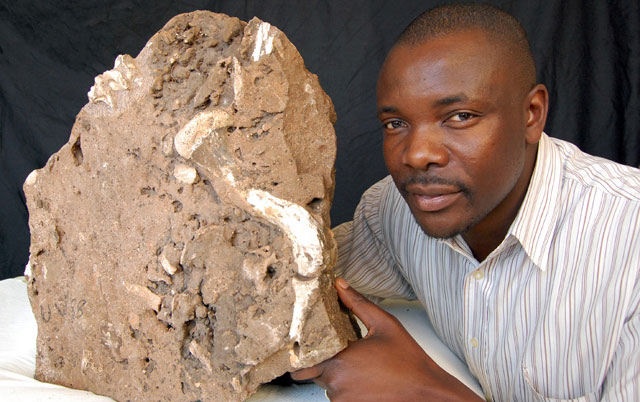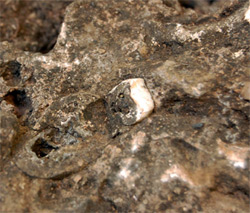Paleoanthropologists at the Wits Institute for Human Evolution in Johannesburg, South Africa, have announced the discovery of a large rock containing significant parts of a skeleton of an early human ancestor.

Justin Mukanku from the Wits Institute of Human Evolution spotted the tooth. On the other side are antelope fossils (Wits Institute of Human Evolution)
The skeleton is believed to be the remains of ‘Karabo’, the type skeleton of Australopithecus sediba, discovered at the Malapa Site in the Cradle of Humankind in 2009.
“We have discovered parts of a jaw and critical aspects of the body including what appear to be a complete femur (thigh bone), ribs, vertebrae and other important limb elements, some never before seen in such completeness in the human fossil record,” said Prof Lee Berger, a paleoanthropologist with the Wits Institute for Human Evolution.
“This discovery will almost certainly make Karabo the most complete early human ancestor skeleton ever discovered. We are obviously quite excited as it appears that we now have some of the most critical and complete remains of the skeleton, albeit encased in solid rock. It’s a big day for us as a team and for our field as a whole.”
The remains are invisible to the casual observer and are entrenched in a large rock about 1 m in diameter. It was discovered almost three years ago, but lay unnoticed in the Wits laboratories until early last month.
In an unprecedented gesture of open access to science and public participation, the University of the Witwatersrand, the Gauteng Provincial Government and the South African national government announced that for the first time in history, the process of exploring and uncovering these fossil remains would be conducted live, captured on video, and conveyed to the world in real time. This will allow members of the public and the scientific community to share in the unfolding discovery in an unprecedented way.

The small tooth, in the center, that was spotted and led to the discovery of the skeleton of Australopithecus sediba in the rock (Wits Institute of Human Evolution)
A laboratory studio, designed in collaboration with the National Geographic Society, will be built at the Maropeng Visitor Centre in the heart of the Cradle of Humankind World Heritage Site. It will allow the public to view the preparation of this skeleton live if they visit Maropeng, or live on the internet.
“The public will be able to participate fully in Live Science and future discoveries as they occur in real time – an unprecedented moment in paleoanthropology,” Prof Berger explained. “The laboratory studio will be also linked to laboratories at Wits University and the Malapa site.”
“We are excited to have helped make this cutting-edge facility possible for the University of the Witwatersrand,” said National Geographic Executive Vice President Terry Garcia. “We can’t wait to watch paleontology happening in real time.”
“It’s breath-taking to actually ‘see the future’ using technology,” Prof Berger concluded. “It unlocks the potential for us to make ambitious plans to share this find with other scientists and with the public. Such an endeavor is quite literally changing the way we conduct science, and it’s a wonderful opportunity to share this magnificent discovery with the world. But, truthfully, my colleagues and I just can’t wait to get our hands on the fossils in that rock!”







